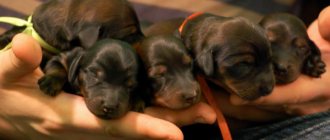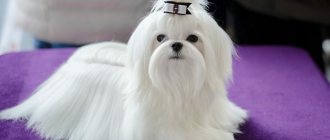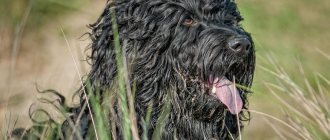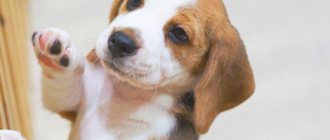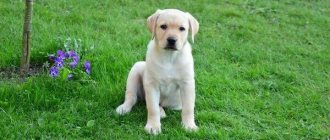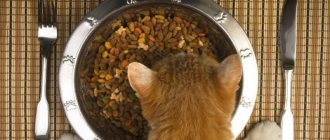The Rottweiler is one of the oldest dog breeds, whose ancestors were recorded in history during the reign of the Egyptian pharaohs.
They served not only for military operations, but also as guards, hunters and family pets.
Officially, the modern version of the Rottweiler was first recorded in the city of Rottweil in Germany, which is why they got their name.
This breed is distinguished by a number of positive qualities that influence the choice in their favor:
- endurance;
- strong skeleton;
- strong muscles;
- easy to train;
- good security guard;
- gets along well with children;
- high intelligence.
Most often, Rottweilers are currently used as guards for houses and apartments , but if desired, they are excellent for hunting large animals . For each individual type of hunting, its own training is selected, as a result of which the four-legged assistant will be an excellent companion for its owner.
Appearance
Video
* We invite you to watch a video about the Rottweiler . In fact, in front of you is a playlist in which you can select and watch any of 20 videos about a given dog breed by simply clicking on the button in the upper right corner of the window. In addition, the material contains quite a lot of photos. By looking at them you can find out what a Rottweiler looks like.
In this article:
|
Rate the material!
[Total votes: 1 Average: 5]
The Rottweiler is an energetic, observant and serious dog; after good training, they make true friends. It is from representatives of this breed that the best guides and rescue dogs emerge, risking their lives for people. On the street, the Rottweiler behaves warily, but at home his character changes completely, he becomes affectionate and kind.
History of the origin of Rottweilers
The ancestors of Rottweilers were dogs from the Molosser group of breeds; they were in many ways similar to Rottweilers in appearance and were very popular in Ancient Greece and Rome. They were used as herding and fighting dogs, and even went on campaigns with the Roman army - usually their task was to guard convoys.
It was with the Roman army that the Molossians came to Germany, where they also began to be bred, and they again returned to what they were originally used for - guarding and grazing livestock. Modern Rottweilers were not developed until the mid-18th century and are said to have fought in the Seven Years' War.
Interesting fact: The breed appeared in the city of Rottweil. It was located at the crossroads and a lot of meat was supplied from it, and first Molossians and then Rottweilers, which were then called Metzgerhund, which is simply translated from German as “butcher’s dog,” were used to guard the convoys.
They are very strong and resilient, which is why they were sometimes harnessed to carts with meat, saving on the maintenance of horses. After the arrival of railroads in this area, the need for Rottweilers disappeared, which is why the breed began to quickly degenerate. There were very few real Rottweilers left when they were remembered again.
This happened because of one very interesting incident. The policeman had an altercation with drunken sailors and, in order to defend himself, he set his Rottweiler on them. The dog caused the sailors to flee from the battlefield, and the press covered the incident throughout the country. As a result, many wanted to have the same protectors for themselves and the breed began to spread again.
At the same time, in the first decades of the 20th century, Rottweilers were brought to Russia. They were mainly used as livestock guards, and then also to guard prisoners in camps. Special, cruel Rottweilers were even bred especially for this purpose.
Rottweiler - description of the breed
These dogs look very athletic, they are medium to large in size, they do not seem outwardly either too heavy or too light, and at one glance you can feel strength, endurance and agility. The average weight is 45 kg for a female and 50 kg for a male, height at the withers is 60 and 65 cm, respectively. The length of the dog's body should be 10-15% greater than the height at the withers.
The breed standards are:
- The skull is medium in size, the forehead is convex, the transition to the muzzle is clearly visible. It itself tapers towards the nose; zygomatic arches are pronounced. The muzzle should be full so that the dog looks “cheeky”;
- The nose is black, looks like a point stretched wide, the nostrils are clearly visible;
- Wide powerful jaws, scissor bite. There should be 42 teeth - 20 on top and 22 on the bottom. A pincer bite does not qualify as a defect, but it is a defect that reduces the score. Lips and gums should be dark or black in color, small light spots are acceptable, but nothing more;
- The eyes are almond-shaped, preferably dark brown; the eyelids should fit tightly to them. The gaze should be open, without signs of malice or cowardice;
- The ears are small and shaped like a triangle. Due to the fact that their edge is located at the very cheekbone area, it seems that the dog has a wide forehead. If the Rottweiler is alert and its ears stand up, folds may form on the head, but in a calm state, folds are unacceptable;
- The scruff is well developed. The neck profile is close to straight, strong convexities are unacceptable;
- The Rottweiler must have a flat back, a wide and voluminous chest, its girth should be 20 cm greater than the height at the withers. A slight convexity of the lower back is allowed;
- Limbs. The shoulder blades are inclined at an angle of 45°, the legs are straight with well-developed muscles, the front legs are shorter than the hind legs;
- The tail is not long. Sometimes they are docked, but according to the standards of the International Canine Federation this is prohibited, and such dogs are not allowed to participate in international exhibitions;
- The dog should have a short undercoat and a coarse outer coat. It is slightly longer on the hind legs. The standard color is black with red-brown tan.
Incomplete compliance with any of the standards may not be critical, unless there are many of them. At the same time, there are a number of disqualifying defects.
These include:
- Different eyes, yellow iris, eyelid defects - entropion or inversion;
- Missing tooth or several;
- Inconsistency with gender type;
- Excessive length or wavy coat;
- White spots (allowed in some places, but only small and in small quantities);
- Maliciousness, cowardice, excessively high excitability.
How to choose a puppy?
Purchasing a Rottweiler puppy from a specialized nursery from trusted breeders minimizes the likelihood of purchasing a sick dog or mixed breed. Before purchasing, you need to ask the breeder to show the living conditions of the dogs, the puppy’s parents and all the necessary documents.
Signs of a healthy puppy:
- the tail is straight, no bends;
- eyes and ears without discharge or unpleasant odor;
- bite – “scissors”;
- dewclaws are missing;
- there are no signs of cryptorchidism;
- nose dark, damp and cold;
- The coat is smooth, shiny, there is no dandruff or rashes on the skin.
A healthy puppy shows curiosity, behaves actively and friendly, and does not show signs of timidity or fear.
IMPORTANT!
You should not choose the largest or smallest puppy in the litter; preference should be given to a medium-sized puppy.
How much a puppy costs depends on its class:
- pet class - 12-18 thousand rubles;
- breed class – 18-50 thousand rubles;
- show class - from 60 to 100 thousand rubles.
Popular Rottweiler colors
The usual color is tan. Its standards are established quite strictly, and deviations from them are classified as shortcomings. The main color is black, with tan marks of brown and red tones.
Stains are allowed only in certain places, namely:
- Under the larynx, on the cheeks and eyebrows;
- On the chest;
- On the inside of the thighs;
- Near the anus;
- From below on the paws.
Puppies have smaller spots than adult Rottweilers, and their boundaries may be slightly blurred. It will be considered a disadvantage if the Rottweiler has too many tan marks or, on the contrary, not enough, their color is unclean. If there are dark spots inside, the boundaries are unclear, like a puppy, or there are white spots.
Let's take a closer look at some cases:
- Fuzzy boundaries - where the stain begins. With it, the black and brown hairs are distributed unevenly, which is why clear transitions are not visible. Because of this, scorch marks may be darker or lighter than usual, or their area may deviate from the norm;
- The black mask on the face appears due to the darkening of the tan marks. Often in such cases, and in other parts of the body, the tan marks are darkened and remain clearly visible only on the dog’s paws;
- Light tan marks are not always recognized as a defect, but only in cases where they are associated with deterioration in the quality of the wool. In the rest, they are considered a defect, and dogs with them can be admitted to exhibitions and even reach high places;
- White spots are a fairly common occurrence in puppies; in most cases they disappear after the first molt. But not always, and dogs who still have them are not allowed to participate in exhibitions. Rarely, black depigmentation occurs, causing previously black areas to turn white. This can happen to a Rottweiler of any age, due to stress or allergies.
What it looks like: description and photo
Let's look at what a Rottweiler puppy looks like, and also give photos of puppies at 1, 2 or more months.
Newborn
From birth, Rottweiler puppies are black in color, with clear light tan markings, mainly located in the area of the almond-shaped eyes, as well as in the cheekbones, neck, chest and paws. Babies' skin is smooth. The ears are hanging, triangular in shape. The tail is elongated.
Babies are born blind and helpless, they move by crawling, so for the first month of life they are highly dependent on their mother and are not able to survive without her care.
By month
Let's describe Rottweiler puppies by month:
- At the initial stage, that is, in the first and second months of life, puppies only need to satisfy their physiological needs. This is warmth, sleep and mother's milk.
- Starting from the second month, puppies are actively growing and developing, adapting to the environment, becoming familiar with their habitat and smells.
- From approximately three months onwards, a particularly important period in a dog’s life begins; this is the process of socialization. The puppy gets used to the environment, begins to feel like a part of what is happening, actively engaging in games with its brothers. At this age, you can slowly begin to train your dog.
- The next stage is called dominance. Sometimes puppies during this period become disobedient and begin to show character. It is important not to miss the moment and show the pet where its place is and who is boss in the house.
- After a year, the dog begins a transition period, active maturation continues, manifested in increasing independence from its owner. Therefore, at this age, the puppy must be actively trained and accustomed to following the owner’s commands.
- By the age of two, Rottweilers reach full physical and mental maturity.
Character and habits of Rottweilers
Because Rottweilers are used as guard dogs, they can be unfairly viewed as aggressive and vicious. In reality this is not the case at all. Dogs of this breed can become very loyal friends, and they attack only when necessary to protect the owner or his property.
But this applies only to well-trained animals; with poor upbringing, a Rottweiler can actually grow aggressive and show anger even towards its owner. But if they do well, they will become faithful protectors, not at all dangerous to the owner and his family; they always behave kindly and affectionately with them.
Interesting fact: These dogs are self-confident - lack of confidence is considered a sign for rejecting puppies, and are very resilient and energetic. They are not lazy, they get to work with enthusiasm, and are ready to protect their owner at any time of the day or night or, for example, carry heavy loads.
During rest, Rottweilers change completely; they love to take a nap, especially on a soft sofa or chair, and they also love to play. Therefore, they can be owned as a family dog, they get used to people quickly, they like when people pay attention to them, play with children and easily tolerate their pranks.
You should still be careful with small children; a well-mannered dog will not show aggression even if the child annoys him, but due to his strength he can accidentally harm him. Rottweilers do not like loneliness and become sad if no one wants to play with them.
Rottweilers become very attached to their owner, and it is difficult to tolerate his change. The dog can become depressed for a long time, become aggressive, and run away. Attachment also manifests itself in jealousy; you don’t need to pet someone else’s animal in front of your pet or treat it with something tasty.
The Rottweiler does not like to share attention with other pets living in the house, but is more lenient towards them. Outside the house, the Rottweiler's behavior changes, and he perceives everyone around him as a potential threat. If he is well brought up, then he will not show aggression without reason, but you should not expect kindness from him either.
It is important to teach him to see the difference between ordinary situations that happen in everyday life and real danger. After all, if he sees a threat, he attacks instantly and without any warning. When he is angry, he feels almost no pain, and it is very difficult to pull him away. Rottweilers are not vindictive, they quickly calm down and no longer try to attack if they believe that there is no longer a threat.
Negative qualities of the breed
We found out whether it is possible to dock a Rottweiler's tail. Not only is it possible, but this is the original standard of the breed. Currently, animals with long tails are allowed for exhibitions. Previously, this was considered a marriage.
We got distracted again. Let's return to the disadvantages of the breed.
- With improper upbringing and lack of authority of the owner, the dog becomes a “killing machine.”
- Very stubborn dogs.
- Due to stubbornness, they may refuse to obey. Therefore, the owner must be firm and persistent.
- Other representatives of the breed are overly aggressive.
- They do not like cats and small dogs.
Let's say right away that Rottweilers are not entirely suitable for beginners. This is a rather tough dog that requires a very responsible and persistent approach to itself.
Interesting facts about Rottweilers
The world's largest Rottweiler lived in England, in the city of Bolton. It was a female named Budel, and by 2006 her weight reached 95 kg, after which an episode of the show “The Fattest Pets” was dedicated to her. The creators of the program noticed that the dog’s health is not at all helped by the fact that it is fed a lot, but the owners refused to change their approach.
Previously, it was customary for Rottweilers to have their tails docked. It was believed that the dog looked more beautiful without them. But animals do not always tolerate the procedure easily, so it was considered inhumane and banned in 1998. Now Rottweilers with docked tails cannot take part in exhibitions. There is still no such ban in Russia.
The Rottweiler's bite force is 140-150 kilograms per square centimeter, so its grip is very strong. In this it is superior to pit bulls, Dobermans, Staffordshire terriers and many other dogs of comparable size. But German Shepherds and St. Bernards bite harder.
In images that have come down to us from the times of Ancient Rome, the ancestors of Rottweilers sometimes appear, and their remains are found in the ruins of buildings of that time. They were not only actively used in the Roman army, but also kept for protection - for example, there is a known story about the dog guarding Gaius Julius Caesar.
Rottweilers are highly trainable due to their intelligence and good memory. In addition, they only enjoy hard work, which is why they were previously used to transport goods. But training may not be the easiest at first. It is important in difficult moments to show only firmness and not cruelty, otherwise the pet will only become embittered.
Pros and cons of Rottweilers
The breed has many advantages, for which many people around the world love them.
Chief among them:
- Intelligence - Rottweilers are very smart, they remember everything well, so they don’t have to repeat the same thing over and over again, like representatives of not so smart breeds. Adapt to the habits of the owners;
- Security qualities - these dogs are always on the alert and ready to prevent an attack on their owner’s property. They can also protect the owner himself, while a well-trained Rottweiler will react only to a real threat, and will not have to periodically try to pull him away from an imaginary threat;
- Loyalty - they become very attached to their owner and are very sad even if they simply lose his interest (but they will not bother him). And certainly such a dog cannot simply change its owner - they take it very hard;
- They can be kept in the apartment. With regular walks, keeping them in the city has virtually no effect on their health;
- Low shedding – when maintaining a house, it is very important that they shed little, so that the apartment will not be covered in fur.
The main disadvantage gradually turns into the advantage of the breed - its decisive and independent character. It is very important to raise your pet correctly and constantly monitor its condition. An improperly trained Rottweiler can cause a lot of problems both for the owner and his family, and for people who accidentally get in his way.
Because of this, many countries have imposed strict restrictions on their content. To adopt a Rottweiler, you must be completely confident that you can train it, and it is highly desirable that it is not your first large pet.
Advantages and disadvantages
Advantages:
- Unlike the standard black and tan Rottweiler, black dogs look unusual and original.
- The black Rottweiler is distinguished by its devotion to its owners.
- This is a smart and quick-witted dog.
- Strong and resilient.
- It is considered one of the best guard breeds.
- It is easy to care for.
- It can live either in the courtyard of a house or in an enclosure, or in a city apartment.
- With proper upbringing, he becomes a wonderful friend for children.
- If you accustom him to pets from an early age, he gets along well with other pets.
Flaws:
- The Rottweiler is a dog that requires serious training and early socialization.
- The owner of such a dog cannot be a child, teenager or elderly person who simply cannot cope with him physically.
- The slightly slow reaction of these dogs can create some problems during training, since the Rottweiler remembers commands more slowly than, for example, a shepherd.
- Keeping such a dog in a small apartment can be problematic.
- It can be difficult to raise a Rottweiler: in the first months of life, he simply rapidly gains height and everything, and therefore even the slightest deficiency or excess of minerals and vitamins can negatively affect his health and, first of all, the musculoskeletal system.
When raising a Rottweiler, you need to walk a fine line between strict but fair and harsh treatment of the animal..
It is unacceptable to shout at these dogs or use physical punishment when raising them: the owner must be the unconditional leader for the pet, but at the same time he should treat the Rottweiler with respect.
Rottweiler breeding
Before mating, special attention should be paid to nutrition. In a month or a month and a half, you need to start giving your dogs antihelminthics, after consulting with your veterinarian. More vitamins, microelements and proteins are added to the dog food. Before mating, as well as after it, a teaspoon of vegetable oil is added to the male dogs’ food once a day.
The first mating is carried out after the completion of the bitch’s third heat, and the second one a day after that. Experienced breeders determine the most suitable dates down to the day; others should seek help from veterinarians, who can determine them using a smear test.
Knitting can be freestyle or hand-knitted. The owners should always remain nearby in case complications arise. Before it is carried out, dogs should not experience stress, otherwise there is a high risk of complications.
It is recommended to bring the bitch to the dog so that the latter feels more confident. There is an opinion that the more matings are carried out, the more puppies there will be, but this is incorrect - their number depends solely on hereditary fertility.
Pregnancy lasts about 9 weeks, but birth may occur a week earlier or later. Puppies that are not due due date may still be healthy, but the dog may require assistance during birth. In the first four weeks, pregnancy shows little sign and there is no need for a special maintenance regime.
The only thing is that it is necessary to abandon antiparasitic drugs and generally minimize the use of drugs. From the fifth week, the dog needs to be fed more actively and use various supplements. What and in what dosage should be determined by the veterinarian; you should go to him for examination at the end of the fourth week.
It is important not to overfeed your pet, otherwise childbirth will be difficult. From the sixth week, the regime becomes gentle, without active games, and walks should become short but more frequent. In recent weeks, the diet has been four meals a day. In the week before giving birth, the amount of food given is reduced by a quarter, and the dog is fed 5-6 times a day.
Important fact: Childbirth should take place in a quiet room without drafts, preferably in a special box with a removable wall and soft fabric at the bottom. There is usually no need to provide assistance, but it is still worth preparing for this and stocking up on everything necessary, from a syringe and ampoules with oxytocin, to special scissors and thread to cut and tie the umbilical cord.
After the birth is over, the dog should be taken out for a walk, preferably in a special overall to protect the nipples from contamination - this will reduce the risk of infection of the puppies. You can start feeding her after 7 hours.
Caring for Rottweilers
Representatives of this breed are quite unpretentious, but they need to be looked after.
Required:
- Walk regularly;
- Bathe at least once a year, preferably two or three;
- Brush frequently with each shedding, otherwise once a week;
- Take him for preventive examinations to the veterinarian;
- Brush their teeth, ears and eyes weekly.
They can live in an apartment, but it is better to keep them in a country house, in an aviary or a booth in the yard. In winter, Rottweilers are taken indoors. If the Rottweiler is kept at home, then be sure to walk it regularly, twice a day, devoting at least a quarter of an hour to this. It is better if at least one of the walks lasts an hour or even longer.
They do not get tired even during long walks. On the contrary, they splash out excess energy and this helps them stay in good shape. With irregular or too short walks, they can begin to get fat and weaken, immunity decreases, and general lethargy is observed, at times turning into irritability.
They tolerate cold temperatures well, so no clothing is required when walking in winter. But they don’t like heat, so in the hot summer you should walk them in the mornings or evenings. If it is warm even at this time, reduce physical activity to a minimum, since excessive activity in the heat is bad for the heart.
But the rest of the time you can’t limit yourself to walking alone; it needs to be combined with other activities: games and other loads. There are lazy Rottweilers (most often this is a gap in education), they need to be stimulated to activity with rewards.
Most often, such stimulation is not needed; they themselves strive to play or carry out the owner’s instructions. If you do not give them stress, not only their physical condition, but also their character may deteriorate.
Care and maintenance
You need to comb your dog every week - this will prevent long hairs from tangling, and the fur will be shiny, but it is better to bathe it when necessary. Ears, which can become infected or inflamed, and teeth, which can develop tartar, deserve weekly care. The claws on the paws are trimmed as needed, usually no more than once a month.
Rottweiler puppies on a walk
Rottweiler diet
Rottweilers have a high appetite, but they should not be overfed. You should strictly monitor how much protein is in their diet. An adult dog is fed twice a day, a puppy up to 6 months old - three times. In total, you should give no more than 5% of your pet’s weight per day. Dry food is given at the rate of 30 grams per kilogram of weight.
Interesting fact: As soon as you notice weight gain, you need to immediately cut the number of calories, even if your pet asks for food. Older dogs also need to be fed less; their metabolism slows down and if they receive the same amount of food as before, they will quickly begin to get fat.
In particular, the amount of carbohydrates is reduced, and they begin to feed them 3 times a day in smaller portions. Once a week, Rottweilers from six months and older should have a fasting day and be given only fermented milk products and water.
The diet of an adult Rottweiler may include:
- Lean meat;
- By-products;
- Sea fish fillet (can be given raw or boiled);
- Eggs, both raw and boiled;
- Cereals;
- Vegetables.
You should not feed him:
- Sausages;
- River fish;
- Sweets;
- Beans;
- Citrus.
Food should be given warm; if it is cold or hot, the pet may develop gastritis. When using dry food, they should not be mixed with natural products, but it is advisable to alternate with wet food.
Be sure to strictly observe dietary discipline, feed the dog at approximately the same time every day, and clean up after 15 minutes. If the pet has not finished eating, the food should not remain in the bowl. Snacks between meals are also not recommended.
The food bowl should be placed not on the floor, but on a stand. At such a height that it is located at the level of the dog’s chest - this will help him develop correct posture. Do not use plastic utensils. It is desirable that it be metal, ceramic or enameled.
How to feed?
The diet of Rottweilers can consist of both natural products and ready-made food.
Both types of nutrition have their advantages and disadvantages, but they cannot be mixed. With natural nutrition, the pet’s menu should consist of:
- lean meat;
- offal;
- eggs;
- cottage cheese;
- buckwheat, rice and barley porridge;
- vegetables and fruits.
You will also need to take additional vitamins and minerals.
You should not give Rottweilers:
- tubular bones;
- pork;
- pickles, smoked meats, seasonings;
- pasta and bakery products;
- potatoes and legumes;
- semolina;
- sweets;
- freshwater fish.
It is prohibited to feed dogs leftovers from the communal table.
Food must be warm. Feeding cold or too hot foods leads to the development of gastritis.
If we are talking about ready-made food, then it should be premium, super-premium or holistic.
The most popular brands of feed:
- Hill`s;
- Royal Canin;
- Eukanuba;
- Purina Pro Plan.
Due to the tendency of Rottweilers to overeat and become obese, it is necessary to adhere to a feeding schedule and control portion sizes and the number of calories consumed.
Diseases and health problems
Like many other large dogs, the Rottweiler's musculoskeletal system is primarily at risk. Regular walking and active games are needed precisely so that the dog constantly warms up and does not have problems with the joints.
You need to closely monitor her health, and if there are any signs of illness, contact a veterinarian. It is also worth considering that a Rottweiler should not sleep on a cold floor. There should be no drafts in the room where he sleeps. Although it seems that Rottweilers are only taken to the veterinarian for vaccination, in reality their immunity is not so strong.
Most often they get sick:
- Ostiomyelitis;
- Willibrand's disease;
- Dysplasia of the hip and elbow joints;
- Retinal atrophy;
- Cataracts;
- Volvulus;
- Aortic valve stenosis.
Diseases of the cardiovascular system are quite common. They can be congenital or acquired, in the second case they develop closer to old age. If you don't start treating them in time, they will take several years of your pet's life. In general, the average lifespan is 9-10 years. But, if you take good care of your pet, it can live up to 12-15 years.
Various skin diseases are also common in this breed. They usually begin due to metabolic or hormonal imbalances. Regular care of your pet's skin and coat reduces the risk of their occurrence, and therefore you should not underestimate the procedures prescribed for this. After all, once a skin disease has appeared, it will be difficult to get rid of it.
Other weak points are the kidneys and eyes. The correct functioning of the former is facilitated by a varied diet strictly in time, but only with the food prescribed for the breed. Your eyes need to be examined regularly and your eyelids taken care of. Puppies have a weakened immune system, which is why they often become infected with infectious diseases.
Training and education
The Rottweiler is prone to dominance; at the slightest opportunity, the dog strives to dominate not only over its own kind, but also over its owner. Therefore, it is difficult for an inexperienced dog breeder to cope with the difficult character of a pet without the help of a dog handler.
Be sure to read our articles:
The dog doesn’t listen or “Who’s the boss?!”
Raising a puppy. Where to start and how to succeed
Under no circumstances should you indulge your dog. Education and training must be carried out firmly, but physical punishment and aggression on the part of the owner are unacceptable. The dog must trust the owner, respect him, but not be afraid or angry. If the above conditions are met, the Rottweiler will quickly learn all the lessons and will obey all commands without question.
During the training process, you need to take into account the fact that the Rottweiler is very smart and at the same time very cunning. If the owner gives a slack, the dog will immediately react to it with further disobedience. It often happens that the Rottweiler refuses to carry out an already learned command, showing with all his appearance that he does not understand what is required of him. This is explained by cunning and deception; the dog simply does not want to work. Having conceded once in such a situation, the owner will concede constantly. In any case, having given a command, it is necessary to ensure its execution.
Interesting Facts
- In Rottweil, butcher shop owners trusted their dogs so much that they entrusted them with the delivery of money. A bag with proceeds was tied to the Rottweiler's collar and sent home. No robber would dare attack such a courier, so the money was delivered safe and sound to the specified location.
- There are cases where a Rottweiler lived for 17 years or more.
- The Rottweiler is capable of transforming at lightning speed. For example, when playing with a child, he frolics like a carefree puppy, but noticing the danger, the dog instantly turns into an aggressive beast with bloodshot eyes and a bared mouth.
- Interestingly, the fearsome Rottweiler’s favorite treat is cheese.
